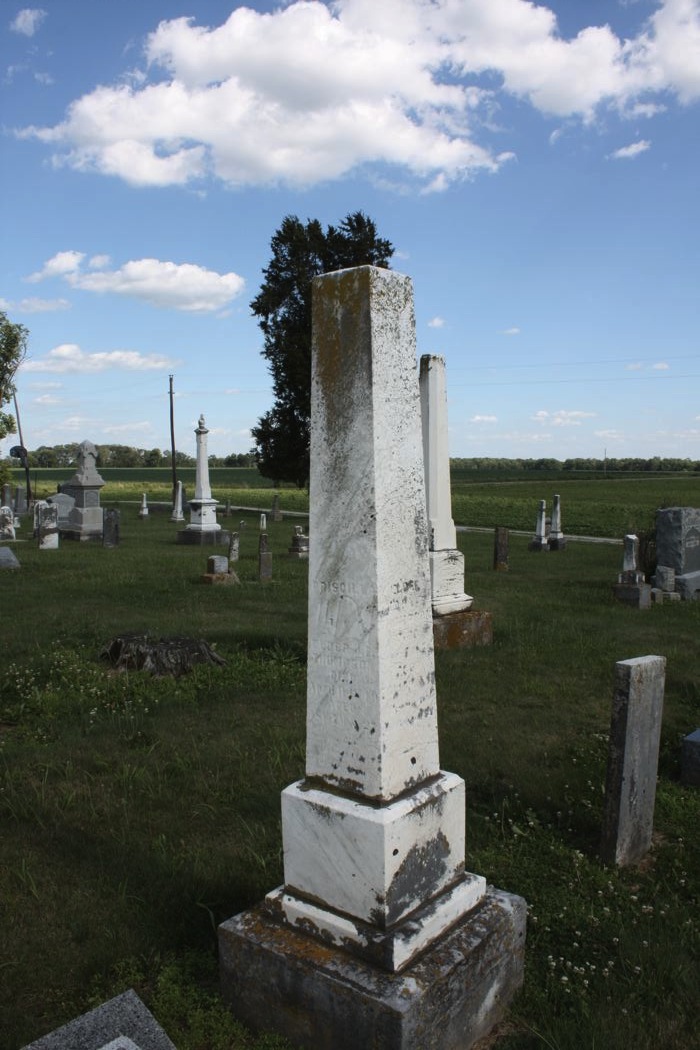John Philips Thompson
1795-1871
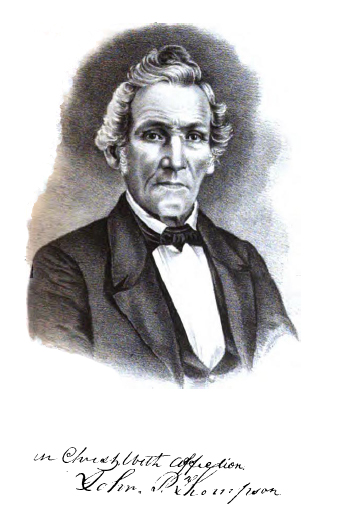
![]()
The Life Of John P. Thompson
Elder John Philips Thompson was born in the city of Washington, D. C, March 6th, 1795. His grandfather on his father's side was a native of Scotland, born in Edinburg, in 1749. About the year 1170 he came to America, suffering himself to be sold for a season to pay the cost of his transportation. He subsequently married Nancy Perry, who is said to have been a distant relative of the hero of Lake Erie. They were blessed with six children, James, the father of John P., being the eldest of their four sons.
Elder Thompson's grandfather served in the Revolution; and an uncle on his mother's side lost his life in the struggle for independence. His father also served eighteen months in the war of 1812, and participated in the bloody and disastrous engagement at the river Raisin. Having survived the awful slaughter of that day, he afterwards joined an artillery company, and applied the match to the guns at the defence of Fort Meigs. He died in peace when almost eighty years of age.
Jonathan Philips, the grandfather of Elder Thompson, (on his mother's side,) was of English descent, and a member of the Church of England. He lived on the eastern shore of Maryland, where his daughter Mary, the mother of Elder Thompson, was born, bred, and married. She was of age at the time of the Revolution; and saw the French army on its march to Yorktown to assist in capturing the forces under Lord Cornwallis. In after years she often described to her children the stirring events, and sang to them the patriotic songs of that era of heroism. By such means she inspired them with the love of liberty, and with an undying devotion to the flag of their country. She attained to the remarkable age of ninety-five years.
In the year 1800 James Thompson removed with his family to Kentucky, and settled near Germantown in Bracken county; whither his father had previously emigrated. The Thompsons were a religious people; and the most of them were members of the Baptist church. The grandfather of John P. was a preacher of that order, noted for the facility with which he could quote Scripture.
As Elder Thompson was only five years old when he came to the West, he claims to be a Kentuckian. His habits, as well as many of his political and religious opinions, were formed and confirmed in that renowned State which contains the graves of his ancestors. There too, he acquired his education, which was not better than that ordinarily received by the children of the West in that day.
Vice, especially in the forms of drunkenness, gambling, and profanity, prevailed all around him; yet through the influence of his pious parents, and in that quiet Baptist retreat, he formed habits of temperance, honesty, and piety, which have successfully resisted all the temptations incident to his long life. He naturally inclined to virtue's side; and he had also a laudable pride which would not permit him to do any thing that would have sullied the good name of his family.
It is perhaps natural, rather than remarkable, that in the midst of scenes of oppression he learned to sympathize with those in bonds; and became a firm believer in the doctrine that "all men are created equal; and are endowed by their Creator with certain inalienable rights; among which are life, liberty, and the pursuit of happiness."
About the year 1805, a division on the subject of slavery took place in the Licking Locust church, which was a member of the Bracken Association. The said Association, in attempting to suppress the anti-slavery element, inflamed the other churches within its confines, and similar divisions occurred in the congregations at Ohio Locust, Lawrence creek, Mayslick, Mt. Sterling, New Hope, Gilgal, and several other points.
This new sect called themselves Friends of Humanity. They differed from their late Baptist brethren only on the slavery question; and proposed to return to their spiritual allegiance provided the Baptists would join them in a petition to the Legislature, praying for the gradual emancipation of the slaves. This proviso not being acceptable to the pro-slavery party, the Friends of Humanity formed an independent Association; and were subsequently among the first to embrace the current Reformation.
Mr. Thompson, though a small boy, imbibed the emancipation views of those people; which views he has held fast to the present day.
It was in the year 1812, and under the ministry of Jeremiah Vardeman, that he was first led to reflect upon his spiritual condition and his obligations to God.
Then came the usual long period of seeking and supplicating; of hoping for the mercy of God, and fearing that he was one of the non-elect.
At last, by a certain train of reflection—not by the knowledge that he had complied with the terms of pardon—he was brought to feel that his burden of sins had been removed. Soon afterwards (being then in his seventeenth year) he united with the Baptist Church, and was immersed by his grandfather.
When in his nineteenth year he was employed as a country school-teacher; and so acceptable were his services in thAt profession that he was retained in the same neighborhood for a period of six years. While thus employed he acquired, by diligent self-instruction, the most of his own education.
When in his twenty-third year, he was married to Miss Priscilla Gregg; all of whose ancestors, as far back as known, were staunch members of the Society of Friends. At the time of their marriage both parties were very poor, their united fortune consisting of only a horse, a cow, and the essential articles of log-cabin furniture. But "better is a little with the fear of the Lord, than great treasure and trouble therewith."
In August, 1819—forty-three years ago—he began to preach the gospel in the community in which he lived. He would have commenced preaching at even an earlier period, but for the fact that he waited a long while for a special call from heaven.
The commencement of his public ministry was attended by a considerable revival of religion; and he at once became a preacher of some prominence. He preached regularly, once a month, for the home church, (Ohio Locust,) and also for the congregation at Lawrence creek. In a short time he began to travel abroad, visiting the churches in Mason, Nicholas, and Montgomery counties.
In the fall of 1819, while on his way to the Baptist Association, held that year in Butler county, Ohio, he stood for the first time upon the soil of Indiana. The following fall he again came to this State on a visit to some of his relatives, who urged him to settle near them. Accordingly he borrowed money, entered eighty acres of land in Rush County, and removed to it on the 22d of March, 1821.
Here he lived for several years in a log-cabin, working hard at the carpenter's bench and in the forest with hand130 spike and axe. At log-rollings, clearings, house-raisings, etc., he was always on hand; and through his influence mainly a rule was established in the neighborhood, prohibiting the use of intoxicating liquors, on all such occasions. He has always been a zealous advocate of the temperance cause.
Very soon after his removal to Indiana he united with the Flat Rock (Baptist) church and began to preach for the same once a month. He also preached monthly at Franklin, near Connersville; and occasionally at Ben Davis Creek, Pleasant. Run, Blue River, and Antioch,
In 1822 he organized a church in Rushville, and had the pastoral care of it during his connection with the Regular Baptists.
In those days he travelled altogether on horseback or on foot, and received but little pay for his services. Ten dollars would perhaps cover all his cash receipts during his stay with the Baptists. Yet he does not complain of their treatment. They too were very poor—so poor that each could almost say with Peter, “Silver and gold have I none.” They esteemed him very highly for his work's sake. The busy-fingered sisters occasionally presented him a homespun coat or vest; and the strong-armed brethren met together, prepared his firewood, split his rails, and made his fences.
In the Fall of 1821 he went as a delegate from the Flat Rock church to the White River Association which met that year at Franklin. Finding that body divided into two parties—some being ultra Calvinists who called the others Arminians—he sided with the latter; took an active part in the discussions, and at once became a leading spirit in the assembly. He was subsequently elected clerk of that body, and more than once had the honor of writing what was called the “circular letter."
One of his letters on the subject of Predestination was printed by the Association; and it did much to modify the views of his ultra Calvinistic brethren. He was at this time very popular as well as influential among the Baptists, to many of whom he, in turn, was ardently attached. But the period of their separation was drawing nigh.
In June, 1826, he became a subscriber for the Christian Baptist. In that he read accounts of remarkable meetings held in various parts of Kentucky by Elders Walter Scott, John Smith, and other pioneer Reformers. Ere long he learned that the tide of reformation had reached his old home in Kentucky: and that many of his friends and relatives were worshipping God in the way which was generally called heresy. Anxious to discover the means which seemed so effectual in turning people from the old paths, he resolved to revisit the scenes of his childhood, and listen to the teachers of the strange, subversive doctrine.
Arriving upon the spot he found the reports true—that those who were turning the world upside down had indeed come thither also. He listened to the views of his friends without losing much of his former faith. He went to hear Elder Abernathy, the chief Reformer in that locality: but even he did not convince him of any superior excellence in what he regarded as the new way.
At the close of his sermon the speaker gave notice that John Smith would preach at that place on the next day. Though Elder Thompson was on the eve of returning home as he had come, he resolved to remain one day longer in order to hear the discourse of one as renowned for his acumen as for his eccentricity. Elder Smith was accompanied by a young brother Payne, who spoke first, presenting the facts and conditions of the gospel with great force and clearness. When he concluded Elder Smith arose; and in his peculiar manner said, "I have no doubt that while my brother was speaking you were thinking as I was, of that passage of Scripture which saith, "The natural man receiveth not the things of the Spirit of God; for they are foolishness unto him; neither can he know them, because they are spiritually discerned.” This very passage had been in the mind of Elder Thompson; and he had employed it to rebut many of the texts introduced by the first speaker. It was, indeed, the keystone of his whole theological system. After listening to the profound exposition of the passage, he seriously doubted the correctness of his former teachings; and without revealing his thoughts to any one he resolved to examine carefully the whole ground.
He entered upon this investigation with fear and trembling; for he had a presentiment that he would find himself in error; and he foresaw the estrangement, the strife, the schism that would result from any attempt to change his position. He spoke of all this to his wife; and with her full consent, he resolved to open his understanding to every ray of light and to follow the truth of God at whatever sacrifice of property, friends, or reputation.
The next time he met with the congregation at Flat Rock, he felt but little inclination to preach; for the old landmarks had been removed, while others had not been firmly established in their stead. However, he took for his text John v. 1, because he could discourse upon that without revealing his new views or his doubts relative to his old ones; and the brethren were well pleased as usual with his teaching.
The next meeting was at a brother Elias Stone's house, an humble cabin with a puncheon floor and a rude porch on one side. A large congregation for that day were seated in the house and on the porch; while Elder Thompson, who by this time had a tolerable knowledge of the Christian system, took his position in the door to declare once more to his humble neighbors “the unsearchable riches of Christ.” He did not intend at that time to bring any “strange things” to the ears of his brethren; but his mind was full of great ideas recently acquired, and his heart was swelling with unfeigned devotion to God and sincere desires for the welfare of his fellow men. When, therefore, he was about half through his sermon, his spirit overleaped all barriers that creeds and traditions had thrown around it; and, as if suddenly inspired, he proclaimed to his astonished hearers the fullness, the freeness, the simplicity of the gospel of Christ.
That morning's service was the beginning of a great reformation in eastern Indiana. Hitherto the people had taken but little interest in the study of the Bible, having been taught that it was designedly incomprehensible to the unregenerate mind. But now all was excitement, searching the Scriptures, animated private discussions, and flocking to the house of worship to hear the public teachers and compare their views with the word of God. The preacher's dixit was no longer profitable for doctrine, nor was the Confession of Faith an end of all controversy. The people were beginning to demand for every tenet a “thus saith the Lord."
There were at that time but three houses of worship in Rush county; and these were merely closed in—not finished. The uncovered sleepers served for pews; a rude box, filled with clay, on which glowed a heap of charcoal, constituted the warming apparatus; and a clapboard, nailed to the top of a couple of great pins or posts inserted in the sleepers completed the substitute for a pulpit. To these houses, when the private cabins would no longer hold the increasing audiences, the worshippers resorted; and they were frequently filled with anxious inquirers after truth, many of whom came a distance of ten or twelve miles, and returned home the same day or night. Elder Thompson was, of course, the chief speaker. He travelled over the whole county, inculcating the doctrine of the apostles so far as he had learned it. The most of the converts of that day have remained steadfast; and the church called Boundary Line, in Wabash county, has now within its pale many of the fruits of the early reformation.
Elder Thompson was still a nominal Baptist. The more orthodox of his brethren had perceived with regret the change that had taken place in his preaching; but they esteemed him very highly as a brother, and on that account were disposed to say to one another, “Let brother Thompson alone: it is owing to the excitement that he fails to inculcate the received doctrines; and when the revival is over he will teach the converts “experience and doctrine"—a phrase which simply meant that he would return to the traditions of the fathers.
Thus matters went on until about sixty members—all Reformers—withdrew from the Flat Rock church with its consent; and, at a more convenient point in Fayette county, were organized as a separate church on the foundation of apostles and prophets.
But he did not long enjoy the blessedness of such toleration. The leading orthodox preachers having given their voices against him, many of his nearest neighbors and most intimate friends could no longer listen patiently to his teaching. At first they endeavored to dissuade him from his course; but he continued witnessing to both small and great, and appealing to the Scriptures as proof that he taught none other things than those which he had learned and received from the apostles. All other means having proved ineffectual, they determined to cast him out of the synagogue. They arraigned him before the congregation, and both prosecution and defense were conducted in the presence of a large and intensely excited audience.
It was finally agreed that the church should decide by a vote whether or not his teaching was heretical; and the vote being taken it was decided by a majority of seven that he taught according to the oracles of God. It being a well established law of the church that the majority should rule in every case, he immediately turned the tables upon his prosecutors; and had he been so disposed, he might have excluded every one of them /or heterodoxy! But he was unwilling to attempt, himself, what he had so recently condemned in them; so the proceedings were discontinued and the Inquisition adjourned.
At the next official meeting it was agreed by the two parties that they should occupy the house alternately for one year. A short time afterward Mr. Thompson and those whose views coincided with his own, formed a separate organization called the Church of Christ; and gave to one another the hand of Christian fellowship.
Thus did he enter fully into the Reformation; and thus did he bring with him out of the Flat Rock church, the nuclei of what are now two large and flourishing churches of the living God.
On the next Lord's day after their organization, an eccentric Baptist preacher by the name of Thomas (commonly called the White Pilgrim, on account of his white raiment) was present, and, by request, preached. A great many “Newlights,” of whom there was a large congregation about two miles to the north, were present on that occasion, and they became greatly offended because not specially invited to the Lord's table. Out of this circumstance there arose a great controversy on the subject of communion, which warfare was zealously participated in by Elders Thompson and John Longley, then a member of the Newlight congregation mentioned above.
At last the difficulty was amicably adjusted. Elder Longley with the majority of his brethren soon came over to the Reformation; and be became also a zealous advocate of the ancient gospel.
In the mean time the congregation was greatly strengthened by accessions from the world, and by immigrant disciples from Kentucky, among whom was Elder Benjamin F. Reeve. He, having already commenced preaching, was soon associated with Elder Thompson in the eldership of the congregation, which they directed and edified with the most perfect unanimity for nineteen years.
So great was the prosperity of the new church that within one year after its organization a new house of worship was erected. None were more liberal or zealous than Elder Thompson in the prosecution of this enterprise.
In the Fall of 1832, John O'Kane first visited Rush county, where be was employed to evangelize for one year. He and Elder Thompson travelled together over the counties of Rush, Fayette, and Decatur, being the first at almost every point to publish the doctrine of the Reformation. When they arrived at Greensburg, O'Kane rang the courthouse bell; a small audience collected; Thompson preached; and one came forward to confess the Lord. This was the first evangelical sermon and the first disciple at that place, which is now the centre of a powerful influence in favor of primitive Christianity. O'Kane followed, and three others made the good confession.
At night they preached at a point four miles northwest of Greensburg; and two were added to the saved—one of them a daughter of a brother North Parker, who is believed to have been the first person that embraced the ancient gospel in Eastern Indiana.
From that point they continued their journey, the people everywhere gladly receiving the word. Though sectarian opposition was very strong; and though there was much ill feeling toward O'Kane, growing out of his active participation in the Presidential campaign; still the disciples were multiplied, new churches were established, prejudices were eradicated, and Bible principles inculcated.
Thus the work was carried forward for several years, Elder Thompson being always in the van.
But about the year 1836 he was compelled to greatly circumscribe the area of his operations. The demands of his large and increasing family could no longer be supplied by however diligent a use of a small portion of his time. Therefore he ceased in a great measure to preach the gospel in the regions beyond his own county. But there, without money and without price, he has continued until this day to warn the unruly, comfort the feebleminded, edify the faithful, and point the children and grand-children of his old pioneer friends to "the Lamb of God that taketh away the sin of the world."
In April, 1849, his wife, who had faithfully shared all his toils and privations, departed this life. She died in faith, leaving with her husband a large family of children.
In 1851 he was married to Mrs. Mary Allen of Connersville; and the year following he removed to his little farm near Fayetteville, in Fayette county, where he expects to pass the remainder of his days. Already tremulous with age; the work given him by the Master well-nigh finished; a large portion of his family beyond “death's cold flood,” and all the survivors, save one, heirs of the kingdom; he is only waiting for the welcome moment that shall pierce the veil of mortality and reveal to him what "eye hath not seen."
He has reserved for his burial place a spot in the old church-yard at Flat Rock, desiring that his dust may repose beneath the old vine, which, planted by his own hand over thirty years ago, now shoots forth its branches over the wall. Elder Thompson is a man of medium height, and slender frame. He was once remarkably stout and active; but heart and flesh are fast failing. His complexion is light. His hair, now white as wool, was once quite dark. His eyes are blue—their expression intelligent, cheerful, benignant.
He is a man of warm and generous emotions; ardently attached to his friends; sincere in his supplications for the whole human family.
Though a man of good natural abilities, yet it is for his goodness rather than his intellectual power that he is so highly esteemed by all who know him.
He is a good speaker and an excellent exhorter. His delivery is fluent and forcible; his manner, grave, very earnest, unostentatious. He pretends to be no more than he is—a plain, humble preacher of the olden time.
Though he has walked for half a century in the midst of a very crooked and perverse nation; yet his Christian character is without spot or blemish.
His whole Christian life has been characterized by supreme devotion to the interests of the Redeemer's kingdom.
At one time especially when sorely pressed for the means of a comfortable subsistence, his friend, Dr. Jefferson Helm, made the most tempting proposals to induce him to exchange the ministerial for the medical profession. But he replied, "I am engaged in a great work, and cannot come down.'"
Having thus steadfastly suffered affliction with the people of God, well may he look forward to the recompense of the reward. Having sown, in tears, the incorruptible seed, he is soon to return, with rejoicing, to the Husbandman, taking his sheaves with him.
-Biographical Sketches of Pioneer Preachers, by Madison Evans, pages 126-138
![]()
1795 JOHN P. THOMPSON 1871
Early in the nineteenth century the question of slavery became a bone of contention in many churches. The Bracken-Baptist Association of Kentucky divided on this issue. The majority were "stand-patters." The antislavery group called themselves "Friends of Humanity," organized a new association, and petitioned the State legislature for a gradual emancipation of the slaves. This brought these early Emancipationists into disfavor with the majority of the body politic.
John P. Thompson as a boy in his teens took an active part in this new cause for freedom. He became so unpopular that he realized his outlook was not bright in Kentucky. Longing for more freedom he anticipated the Mason and Dixon line in March, 1821. Like many another adventurer of these early days he was both a schoolteacher and a preacher. -When he came to Rush County he found an opportunity for all his splendid talents.
He united with the Flat Rock Baptist Church and began to preach for them once a month. In the fall of this year he was sent as a delegate to the White Water Baptist Association. He was elected secretary of this yearly meeting. This group was divided into two parties called the "Means" and" Anti-Means" Baptists. This gave him no little trouble. To add to his confusion in the year of 1826 he subscribed for the Christian Baptist, in which he got accounts of remarkable meetings being held near his old home. Newcomers brought to him interesting stories of what was happening in Bracken and adjoining counties in Kentucky. He resolved to visit the scenes of his childhood and investigate these new teachings.
He visited his old home in the summer of 1828. The leading preachers were Walter Scott and Raccoon John Smith. Scott made him think. Smith stirred his feelings. He was so thoroughly aroused that he returned home with a new message in his heart. He foresaw the strife and schism that would result in any attempt to change his position. He weighed this matter, spoke of it to his wife, and with her consent resolved to "open his mind and heart to every ray of light and to follow the truth of God at whatever sacrifice of property, friends or reputation." At the next meeting he felt little inclined to preach. His old landmarks had been removed. There was little enthusiasm in his message. The next meeting was held at the home of Elias Stone. It was a small cabin, and a large congregation assembled. Mr. Thompson took his position at the door so all could hear. He did not intend to bring any" strange things." But as he warmed to the occasion the new ideas recently acquired began to stir in his heart. With devotion to God and a sincere desire for his fellowmen, when about half through his sermon, his spirit overleaped all barriers that creeds and traditions had thrown about him. .
As if suddenly inspired he proclaimed to his astonished hearers, the "fulness, the freeness, and the simplicity of the gospel of Christ." Madison Evans says, "That service was the beginning of the Reformation in eastern Indiana. Hitherto the people had taken little interest in the study of the Bible, but now that Book is made the most popular one in the community. The people began to call Bible things by Bible names, and to demand a 'Thus saith the Lord.' At this time there were only three houses of worship in Rush County. Thompson was still a nominal Baptist and did not want to cause a division. He was held in high esteem by his church. The orthodox brethren regretted the change that had taken place in his preaching, but they had great faith in him. They said, "Let Brother Thompson alone; when this excitement is over he ,viii teach the converts experience and doctrine. Then he will return to the teachings of the fathers."
At this time we want to introduce to you Ryland T. Brown, twenty years old. You will see him on the stage of action many times in the next sixty years-if you read on. In his address at the Semi-Centennial of the Little Flat Rock Church, delivered on May 15, 1880, he says: "In the spring of 1827 there occurred the first visible ripple on the surface of religious society in this region. The Flat Rock Baptist Association had issued a request that all churches of that jurisdiction conform their articles of faith to the form adopted by the Association. The church on Clifty, of which I was a member, proposed to comply with the request, and a motion was made to rescind the existing articles and adopt those of the Association. I moved a division of the question and the articles were revoked without a dissenting vote. Then I immediately moved that the New Testament be adopted as the exponent and measure of our faith. My motion was seconded and came fairly before the church. For two hours the church struggled to avoid a direct vote rejecting the New Testament, and finally succeeded in laying my motion on the table. Returning from the Medical College in Cincinnati in the spring of 1829 I found the whole country moved by an intense religious excitement, the central figure of which appeared to be John P. Thompson, of the Little Flat Rock Church. He was preaching every night at schoolhouses, private homes, and in a few meetinghouses, going from neighborhood to neighborhood and baptizing the people without waiting for the church to hear their experience and decide on the soundness of their conversion."
"I understood what all this meant, for I had heard some of the great leaders in Cincinnati."
The crisis sooner or later inevitable was now at hand. On the fourth day of July, 1829, sixty members of the Flat Rock Baptist Church withdrew to organize a church at Fayetteville in Fayette County, taking the Scriptures as their rule of faith and practice. They applied for membership in the White Water Baptist Association and one of their elders presented the New Testament as their articles of faith. The application was referred to a committee, with instructions to inquire into the case and report the next year. The report was never made.
"Other churches took this advanced ground previous to this date," says Dr. Brown, "but this was the first church to come into what was later called the Reformation, knowing the full import of their action." This church was known as the Orange Church at the close of a century, and they had a splendid centennial celebration on the first Lord's day in July, 1929."
-Disciples Of Christ in Indiana, Cauble, p. 46-48
![]()
Directions To The Grave Of J. P. Thompson
The Little Flat Rock church and cemetery is located SE of Rushville, Indiana. The church is located in Rush County at 2471 S 450 E, Rushville, Indiana 46173, (phone: 765.932.4900).
GPS Location
39°34'39.2"N 85°21'34.3"W
or D.d. 39.577550,-85.359517
![]()
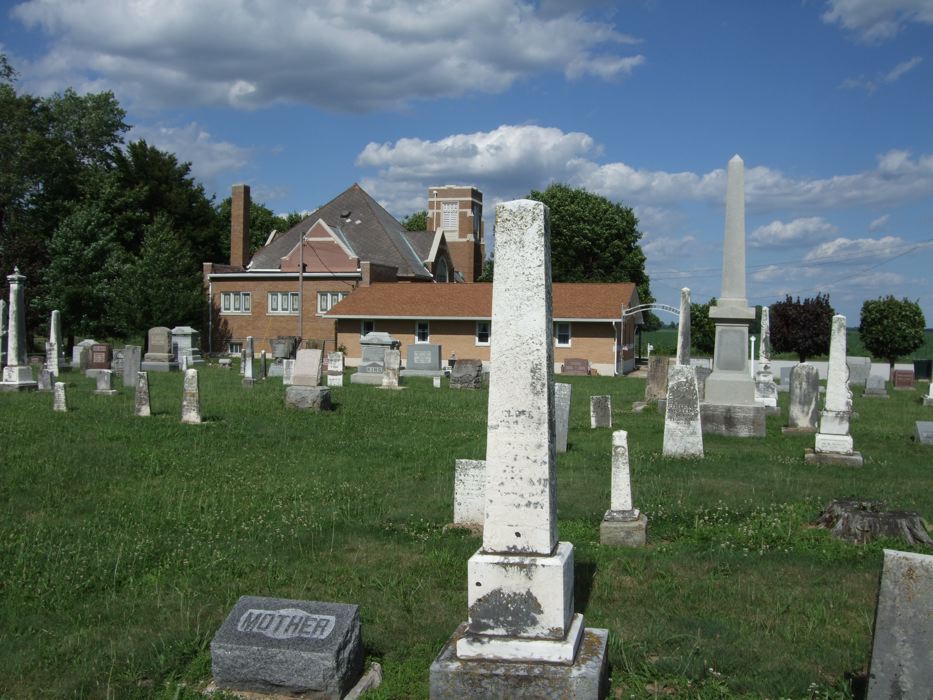

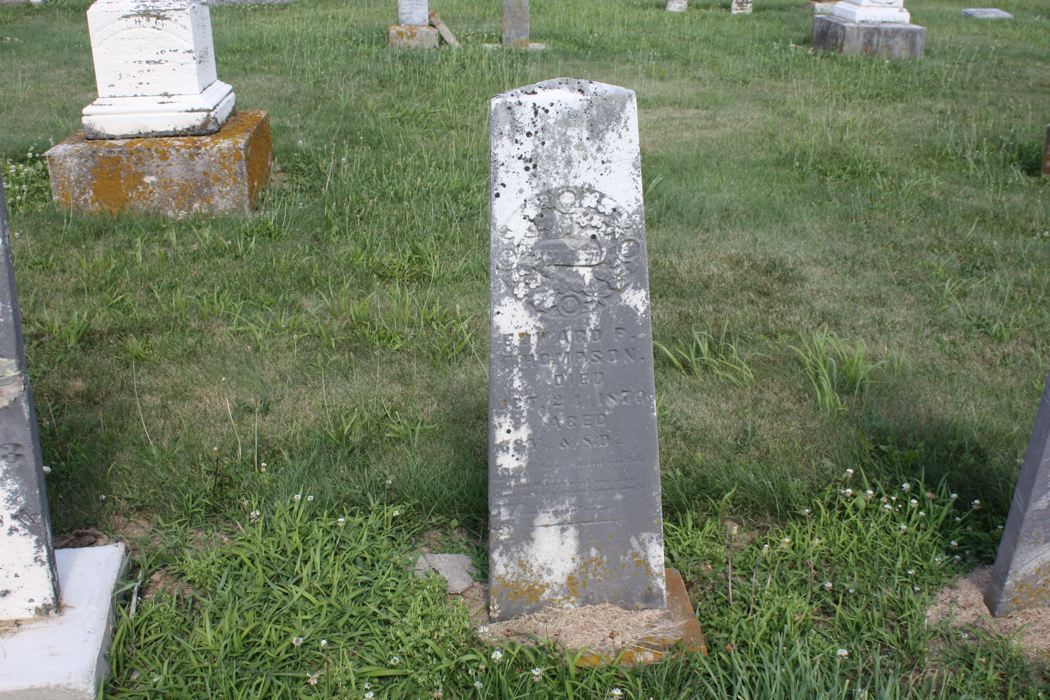
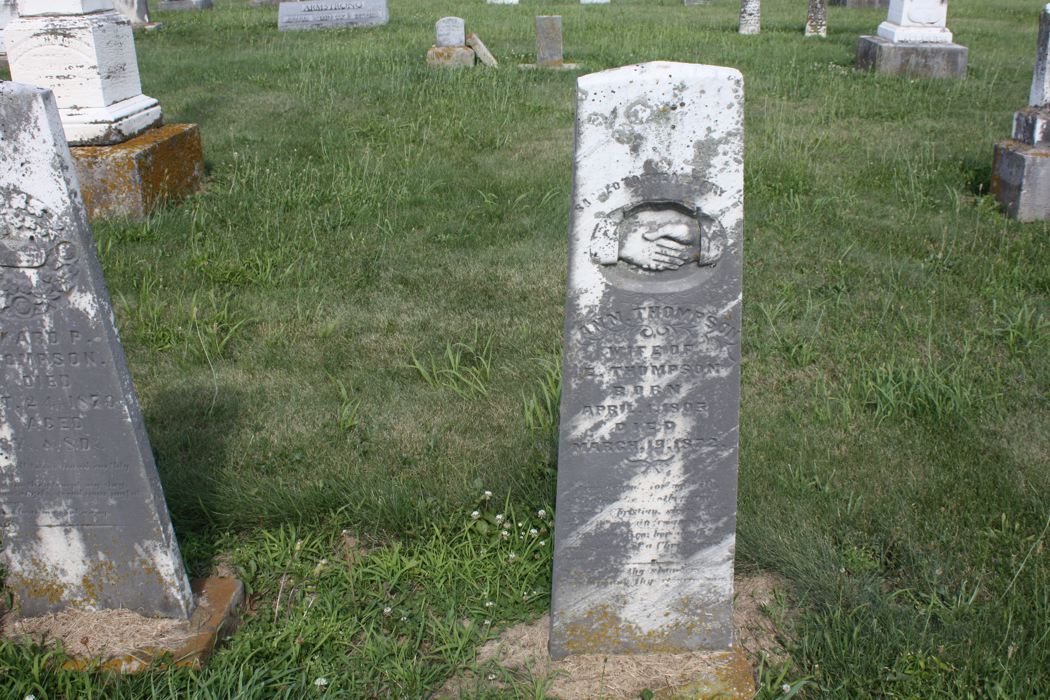
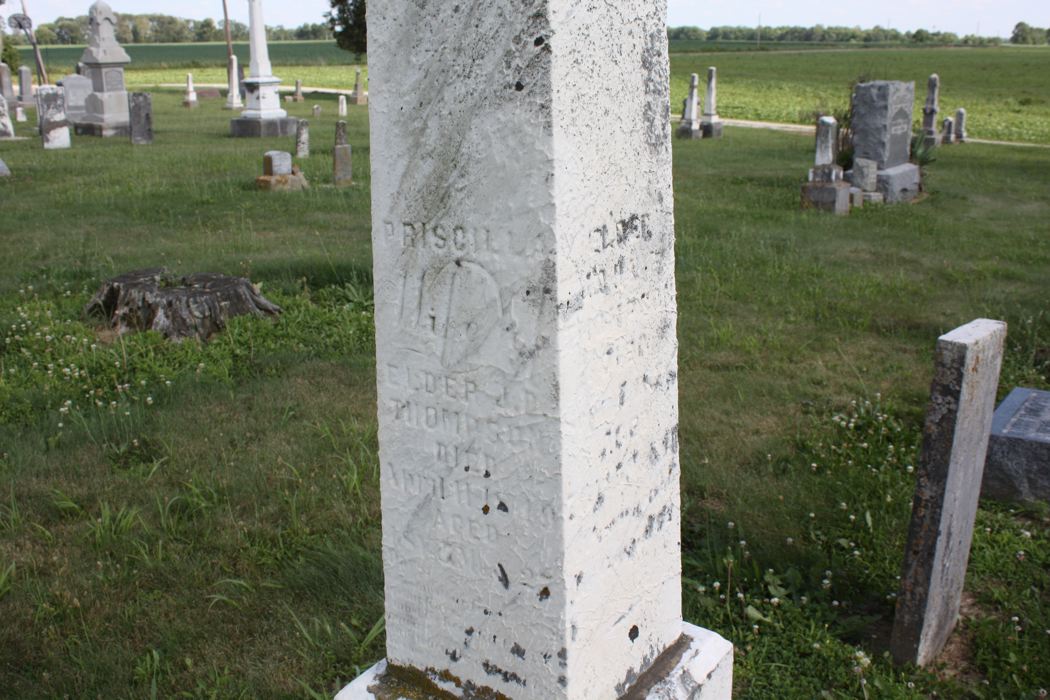
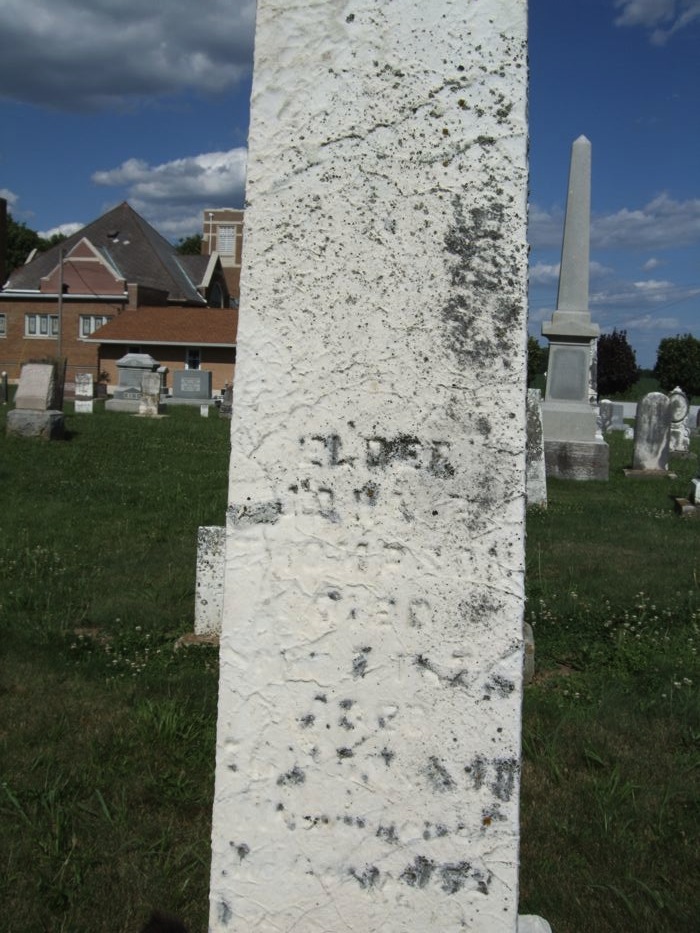
Elder John P.
Thompson
Died
??? 1871
Aged
????????
![]()
Special Thanks
In June, 2009 Tom L. Childers, C. Wayne Kilpatrick and Scott Harp traveled about 3000 miles in one week through parts of Tennessee, Missouri, Illinois, Indiana and Kentucky. During this time we found the graves of 75 church leaders in the Restoration Movement. Chronicling these leaders into websites has been time consuming. Many thanks to Tom and Wayne in helping to take photos, share the driving, and putting up with your web master's slave-driving effort to see as many as we did in the time we had. Their photos as well as some of mine are seen on this site.
![]()
